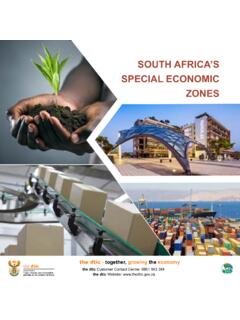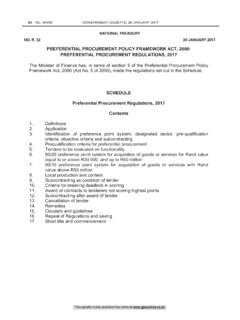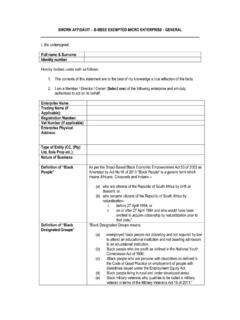Transcription of The South African Poultry
1 The South AfricanPoultrySectorMaster Plan November 2019the dtic - together, growing the economythe dtic Customer Contact Centre: 0861 843 384 the dtic Website: , Industry and Competition Department:REPUBLIC OF South AFRICAthe dticContents1. Introduction ..22. Overview and background analysis ..43. Strategic objectives ..64. Required actions ..85. Support for the Poultry Master .. 15 Acronyms used in this reportAfCFTAA frican Continental Free Trade AreaAgriSETAA gricultural Sector Education Training AuthorityAMIEA ssociation of Meat Importers and ExportersBEEB lack Economic Empowerment DALRRDD epartment of Agriculture, Land Reform and Rural Development DOHD epartment of Healththe dticDepartment of Trade, Industry and CompetitionEBIESA Emerging Black Importers and Exporters of South Africa EUEuropean UnionFAWU Food and Allied Workers Union FoodBev SETAThe Food and Beverage Manufacturing Sector Education Training Authority IDCI ndustrial Development CorporationITACI nternational Trade Administration Commission MDMM echanically Deboned MeatSASouth AfricaSABSS outh African Bureau of StandardsSADCS outhern African Development Community SAPASA Poultry AssociationSARSS outh African Revenue ServiceSPSS anitary and Phyto-SanitaryStats SAStatistics South AfricaTIPST rade and Industry Policy Secretariat The Department of Trade, Industry and Competition (the dtic)
2 , November 2019 Photos are royalty-free stock images, courtesy of the dtic photo dtic Campus77 Meintjies StreetSunnysidePretoria0002the dticPrivate Bag X84 Pretoria0001the dtic customer contact centre: 0861 843 384the dtic website: Poultry Sector Master Plan has been developed in a close partnership between Government and a number of stakeholders in the industry, drawn from Poultry farmers, processors, exporters, importers and organised labour. It provides a framework for a determined effort to grow the output (and jobs) in the industry through a number of measures that will be implemented over a number of years. Significantly, it sets out a new, joint vision across the value-chain, identifies five pillars that underpin the vision and creates a Poultry Sector Master Plan Council to monitor and drive implementation of the pillars.
3 The parties that contributed to the Master Plan include: The Ministries of Trade, Industry and Competition as well as Agriculture, Land Reform and Rural Development (DALRRD) Local Poultry producers, through the SA Poultry Association (SAPA) as well as a number of independent producers, including Poultry farmers who are contracted to large integrated producers as well as independent producers Poultry traders, represented by their industry bodies, the Association of Meat Importers and Exporters (AMIE) and Emerging Black Importers and Exporters of South Africa (EBIESA) Organised labour, through the Food and Allied Workers Union (FAWU) Other interested parties including the South African Association of Meat Processors Government entities, through the Department of Trade, Industry and Competition (the dtic); the Department of Agriculture, Land Reform and Rural Development; the Department of Health; the Trade and Industry Policy Secretariat (TIPS), the Industrial Development Corporation (IDC); the Land Bank; and the International Trade Administration Commission (ITAC).
4 Each constituency recognises the need for it to contribute practically to building a strong and competitive industry, and the Master Plan sets out the commitments by the parties. Introduction123 The Poultry sector plays a key role in South African life: It provides an important, affordable source of protein for millions of households, and is a staple of the South African dinner table It is a pillar of the South African agricultural economy, adding value to our maize and soya crops, and serving as a key customer of the farming sector, including a significant number of emerging farmers Barriers to entry are reasonably low, allowing emerging farmers and small scale participants and local economies to supplement industrial scale activity Poultry is also an important sector of food processing, adding value and creating jobs throughout the length and breadth of the demand for Poultry products has grown substantially in the democratic era, partly reflecting higher incomes across the South African population.
5 For the first 15 years of democracy, the production of Poultry also grew but this began to stagnate around 2008. Production has been static for the last decade despite the fact that consumption has continued to grow. This has happened because imported Poultry has come into the economy in large quantities, displacing South African meat especially at the lower end. Tariffs were increased substantially in 2013, but this has not arrested the growth in imports. Some of our large Poultry production companies are regarded as highly efficient in their production systems. Despite this we have been unable to compete effectively with imports especially at the lower end of the price range, and we have failed to grow exports. Overview and background analysis2 Figure 2: SA Poultry Imports, 2013-2018 (tons)Figure 1: SA Poultry Production, Consumption and Imports, 2011-2018 (tons)0500 0001 000 0001 500 0002 000 0002 500 0002011 ProductionImportsConsumption201220132014 20152016201720180200 000300 000400 000500 000600 0002013 Total Poultry importsChicken meat excl MDM20142015201620172018 MDMBone in portionsBoneless cutsWhole bird100 000 Figure 1 demonstrates clearly that: Consumption of chicken meat in South Africa has grown substantially although more slowly after 2008 Production has stagnated as imports have risen, with imports having risen fourfold over 20 years.
6 The potential growth in local production has therefore been displaced by imports. This has mainly been due to the lower prices at which imports have come into our market. Market conditions and trade agreements have brought significant quantities of low-priced chicken products into our market. These have put pressure on local prices and reduced the market share of South African producers. While there may have been benefit for consumers, we have been unable to drive growth in the industry. At the same time we have been unable to make up the differential through exports. At present South African Poultry exports are marginal at about 2% of production despite excellent access to a variety of markets. As a result, our industry is now vulnerable, and faces significant threats to our existing capacity. Detailed trade figures demonstrate that imports have continued to grow even when we exclude meat products that are not made in South Africa such as Mechanically Deboned Meat (MDM).
7 Indeed, imports of broiler meat (excluding MDM) have increased by 73% over the past five this trend is not reversed then the South African industry can be expected to stagnate and slowly decline affecting jobs and livelihoods across the value chain from maize and soya farming to food processing. It would also threaten our food security in the longer term. Urgent challenges facing the sectorIt is clear that the South African industry faces critical challenges, some of which are structural and others that are driven by factors over which we have greater control:1. Cost of feed: The cost of feed makes up a large portion of the cost of chicken production. Maize and soya prices are determined internationally but tend to rise for South African producers in drought years. Many countries subsidise their primary farming sector, allowing cheaper inputs to their Poultry Scale of production: The reasonably small scale of production in South Africa makes us vulnerable to exporting countries which exploit economies of scale.
8 In addition, we tend to slaughter broilers at a lower weight than our competitors, placing us at a disadvantage in certain markets. 3. Segmenting production: In recent years several large Poultry exporting countries have targeted South Africa s market for brown meat. These exporters provide white meat to the European and American market where much higher prices are paid for breast meat, and exported the remaining brown portions to South Africa at low prices. This is known in the trade as balancing the carcass and is widely Inability to export: Despite the fact that we have tariff-free access to Europe we have not been able to export Poultry to Europe largely because we have not developed the necessary systems to meet the sanitary and phyto-sanitary requirements of the European market. Our exports to other countries are also very limited, with exports making up no more than 2% of production.
9 This has limited our ability to compete, and to grow our Transformation: Although some progress has been made, we have not moved sufficiently with regard to black ownership throughout the value chain. Some immediate opportunities exist to improve the situation. 45 Poultry farming offers important opportunities for economic development in South Africa including: Potential expansion of both maize and soya production Growing small-scale Poultry farming and local production networks Commercial-scale contract farming supplying large integrated producers Growth in industrial-scale food processing, leading to increased employment and exports The supply of affordable protein to South African householdsIn line with these opportunities, South Africa needs to grow the Poultry sector and to protect against potential loss of capacity.
10 Indeed, there is substantial potential to expand the Poultry industry across the value chain, especially if we can develop substantial export strategic outlook on trade can be described as follows: Poultry is an increasingly traded product. Poultry producers are effectively divided into two groups a large group of countries that produce at the scale of their domestic market and a smaller group that produce at greater scale and maximise exports. South Africa has fallen into the former group and has been targeted by countries that are pursuing an export oriented strategy. Given the fact that we have a fairly large market for Poultry and an open economy we are likely to continue to receive attention from exporters. Imports have an important role to play in balancing our Poultry sector. In particular: Imports can help to keep local prices in check There are certain Poultry products that do not get produced in South Africa (such as MDM) that need to be imported There are certain cuts that are produced locally but where demand outstrips local supply, especially at certain times of the year At the same time, we need to expand our Poultry sector and avoid losing local capacity.









